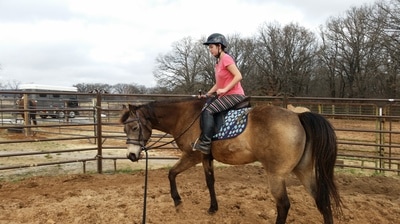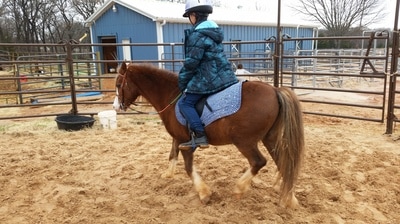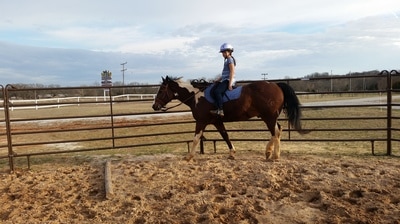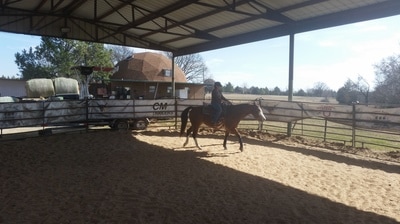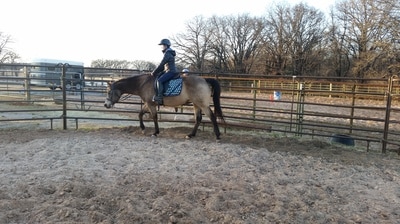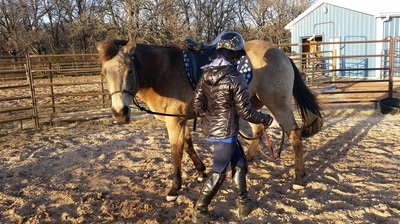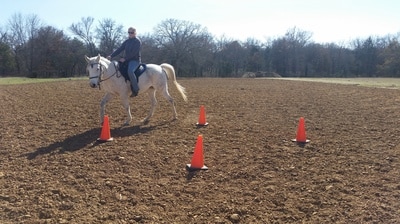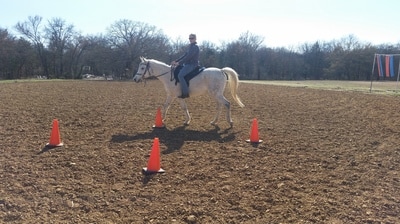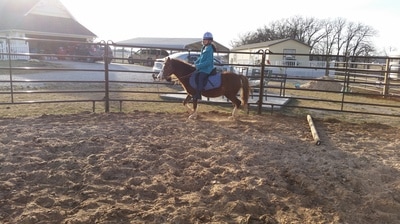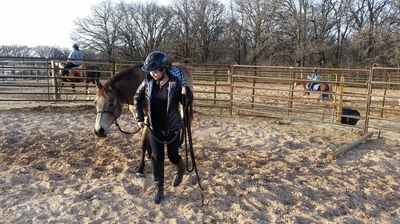|
Some more great exercises to work on when its cold or your short of time, is flexing and being able to move the shoulders and hips independently.
The flexing comes first. Flexing is a basic that most all horses will learn (not all) and is one of the important steps to steering, one rein stops, etc. It's also the start for moving the hips. To start with flexing, stand on the side of the horse near the withers. Pick up so there is contact with the lead rope. If your horse struggles with this, go wider out to the side vs up close to the horses' body. Increase pressure every 3 seconds, but only in small intervals until you feel your horse THINK about flexing. Then release. This is step one. Step 2 involves repeating the above, but go one step further and when your horse thinks it, this time just wait a little longer till the horse actually give just a hair width and then release. Your goal is to have the horse eventually bring his head all the way around to you almost to where you leg would be in the saddle. But its baby steps first. Do this on both sides. Depending on the horse, this may be as far as you get for one day. If the horse walks off or walks in a circle, stay with the horse and keep the same amount of contact on the lead rope. Only release once the horse is soft and standing still. Over time and with practice you can increase the amount that the horse brings his head around to you. Again, patience, time and practice. Once your horse gets good with flexing, and is light in doing so, then you can move to the next step of moving the hindquarter. I often hear the same complaints every year about this time of year “It's too cold, its dark already!”. The same complaints get old, especially when I'm doing lessons and I show up on a weekly basis and nothing has been done again for the homework I originally gave my riders. But here's the thing, those are just excuses. There are plenty of good exercises to continue to be able to do at least once or twice a week, if not more. Sometimes you need to get a little incentive on how to do them, but, I promise there is always a way.
The first thing is giving your horse a good brushing or grooming. This is so good for more than one reason. It not only is good for the horses coat, but also teaches your horse to either ground tie (the harder approach) or to stand tied while you work around him/her. You may also choose to hold the lead rope and have the horse stand while you brush. Grooming the horse not only help with circulation and blood flow and getting the oils of the coat dispersed more evenly, it also gives you the opportunity to check the horse over and notice any new cuts, nicks, bite or kick marks, or fungus or rain rot that may be showing up. Its easier to treat something while its small before it gets too out of hand. Grooming a horse can be done while in a barn or stall as well. Meaning, that you may have access to lights to be able to do so. If you don't have access to a barn/lights, you can get creative in making light. This may mean investing in a solar powered light to do some of your work, or even a head lamp. A headlamp is great to be able to get the horses to used to as they come in handy for having to do chores in the dark if needed. It also helps to desensitize the horse as they can be spooked sometimes just seeing an odd shape with a beam of light coming off of it (aka, you with the beam). Grooming your horse also allows for more trust being built between the two of you. Horses don't want to just be caught and have to work all the time. Horses enjoy having a change of pace once in awhile and also teaches them that you aren't' always “here to ride”. Horses can get bored (hence the term arena sour) and enjoy new things occasionally. However, teaching good manners while you groom is also just as important. Grooming often feels good to the horse and will enjoy it (a lot like watching other horses in the pasture groom each other). You may also notice if your horse is keeping a healthy weight by seeing your horse more regularly, which is extremely important through the cold months. Using your bare hands, you can rub your hand along their ribs as the thick hair can easily hide ribs that would otherwise be showing if they didn't have long hair. Or, perhaps your horse looks “good” but you realize by rubbing your hand that you feel more flab and your horse needs to go on a diet or get more exercise. Picking out your horses feet is just as important as the grooming. It should be part of the grooming process to notice any new cracks, stones or rocks that have been picked up, or if shoes are overgrown even though you haven't reached the 8 week mark. Regularly picking out a horses feet also allows you to check for fungus or bacteria like thrush and treat it sooner so it doesn't cause any issues. It will also help reduce the chances of getting an abscess, however some horses are just more prone to them. Grooming is a first start to being able to touch places that the horse may not like being touched. A good example is the ears. Many horses dislike their ears messed with as they may have had the bridle too tight when someone goes to put the bridle on and it will mash their ears down. If you find a place that your horse doesn't like being touched, work slowly on that over the next couple days/weeks. For example, a horse that doesn't like his ears touched, I will gradually move my hand further up until I hit resistance and then come back down to a comfort zone. And gradually work back up to where I know the horse isn't as comfortable. I may hold my hand there for a second or two, before going back to a comfort zone. Gradually leaving my hand longer and gradually going further up towards his ears as I work with the horse. This usually doesn't happen in a day. I work up towards their ears over the next couple days, getting the horse to realize I won't hurt them by touching their ears. There are more things to do on a cold, winter day, and over the next couple weeks I'll add to the list. So bundle up, head out to your horse, and enjoy being able to take 10 or 15 minutes to being with your horse. |
Categories |
 RSS Feed
RSS Feed


